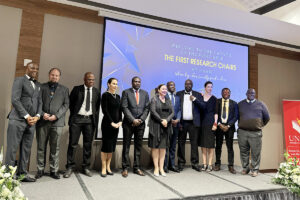Situated about 120 km south-west of Namibia’s Capital, Windhoek, is the world’s leading gamma-ray observatory, the High Energy Stereoscopic System (H.E.S.S.) The system is used for detecting gamma rays that carry more than a billion times the energy of visible light; probing the most violent places in the Universe, including black holes, neutron stars, and supernova remnants.
Over the years, successful endeavors, like the H.E.S.S. project, have helped Namibia attract other large scale collaborative projects to Namibia. Recent examples of other large scale astronomical projects that have considered Namibia as host country include the Cherenkov Telescope Array, the Square Kilometer Array, and the Africa Millimeter Telescope. The latter two have chosen Namibia as their future host.
A delegation of senior officials from the University of Namibia recently visited the site. The team consisted of the Vice Chancellor, Prof. Kenneth Matengu, the Pro-Vice Chancellor for Academic Affairs, Prof. Frednard Gideon, and the Pro-Vice Chancellor for Research, Innovation and Development, Prof. Anicia Peters, the Director for External and International Relations, Dr Romanus Shivoro and the Dean and Deputy Dean of the Faculty of Science, and a number of support staff.
Guided by Head of the Namibian H.E.S.S. group, Dr Michael Backes, from the UNAM Faculty of Science, Physics’ department, the delegation was treated to a rare opportunity to learn about the latest developments on the H.E.S.S. project. This is in line with the project’s objective to enhance local involvement.

The visitors were left speechless as they marveled at the 600 ton steel structure, and the 600 square meter mirror configuration – one of the largest mirror telescopes in the world. Dr Backes, gave a detailed introduction of the project to UNAM Management. He further outlined the academic advantages and benefits of UNAM’s involvement in this internationally highly reputed project. Amongst others, UNAM students and staff are actively involved in developing the science behind these telescopes, while enhancing human capital development in astronomy and related technologies, such as, ultra-fast electronics and computing in fields of Machine Learning and Big Data.
For enhancing Big Data and local High-Performance Computing (HPC) capacities, UNAM received large storage servers from other H.E.S.S. member institutes. These will be integrated in the HPC cluster at UNAM, which is administered by the Virtual Institute for Scientific Computing and Artificial Intelligence.
“Economically, these projects are an added bonus for the country, as many services are rendered locally”, remarked Dr Backes. He later further explained that, the expenses of maintaining the H.E.S.S. project are more than justified by the scientific productivity of this collaboration, currently consisting of over 40 institutions from over 13 countries. H.E.S.S. customarily publishes groundbreaking findings in highly prestigious journals, like Nature or Science, biannually. The most recent publications were in June 2020, titled “Quasar jets are particle accelerators thousands of light-years long” and November 2019, titled “A very-high-energy component deep in the gamma-ray burst afterglow”.





